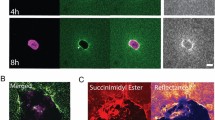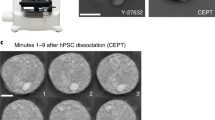Abstract
This paper describes a protocol to encapsulate cells in sub-millimeter-sized cylindrical collagen modules and to assemble these modules into a tissue-engineered construct within a continuous loop flow circuit. Modules are fabricated by gelling a solution of collagen, that contains suspended cells, within the lumen of a small-bore polyethylene tube. The tubing is then cut into short lengths using an automated cutter and gently vortexed to remove the cell-containing collagen modules from the tubing lumen. Modules are then randomly assembled into a modular construct by pipetting a suspension of modules into a larger tube that is positioned within a continuous flow circuit. A range of cylinder aspect ratios are achievable; therefore, this method could potentially be used to create short discs or, alternatively, long threads of soft gels, with or without encapsulated cells, for a variety of tissue-engineering applications. Module fabrication requires 1 d and assembly of a modular construct requires 2 h.
NOTE: The title of the article is incorrect as published. It should read: "Fabrication of cell-containing gel modules to assemble modular tissue-engineered constructs".
This is a preview of subscription content, access via your institution
Access options
Subscribe to this journal
Receive 12 print issues and online access
269,00 € per year
only 22,42 € per issue
Buy this article
- Purchase on SpringerLink
- Instant access to full article PDF
Prices may be subject to local taxes which are calculated during checkout




Similar content being viewed by others
Change history
08 March 2007
The title of the article is incorrect as published. It should read: "Fabrication of cell-containing gel modules to assemble modular tissue-engineered constructs".
References
Langer, R. & Vacanti, J.P. Tissue engineering. Science 260, 920 (1993).
Nomi, M., Atala, A., Coppi, P.D. & Soker, S. Principals of neovascularization for tissue engineering. Mol. Aspects Med. 23, 463 (2002).
Carmeliet, P. & Jain, R. K. Angiogenesis in cancer and other diseases. Nature 407, 249 (2000).
Kim, B.S., Putnam, A.J., Kulik, T.J. & Mooney, D.J. Optimizing seeding and culture methods to engineer smooth muscle tissue on biodegradable polymer matrices. Biotechnol. Bioeng. 57, 46–54 (1998).
McGuigan, A.P. & Sefton, M.V. Vascularized organoid engineered by modular assembly enables blood perfusion. Proc. Natl. Acad. Sci. USA 103, 11461 (2006).
Sosnik, A. & Sefton, M.V. Biomaterials 26, 7425–7435 (2005).
Lahooti, S. & Sefton, M.V. Methods for Microencapsulation with HEMA-MMA. Methods in Molecular Medicine. Vol 18: Tissue Engineering Methods and Protocols (eds. Morgan, J.R. & Yamush, M.L.) 331–348 (Humana Press Inc., Totowa, New Jersey, USA, 1999).
Acknowledgements
We would like to acknowledge Z. Fang, of FCS Technologies Inc., and T. Fixler for technical assistance; and the National Institute of Health (EB001013, co-investigators E. Yeo and A. Gotlieb) and the Natural Sciences and Engineering Research Council for funding. A.P.M. and B.L. acknowledge the fellowship support of the Province of Ontario and the Canadian Institutes of Health Research Training Program in Regenerative Medicine.
Author information
Authors and Affiliations
Corresponding author
Ethics declarations
Competing interests
The authors declare no competing financial interests.
Supplementary information
Supplementary Figure 1
Automatic cutter concept drawing (PDF 74 kb)
Supplementary Figure 2
[a–d] Module fabrication process (PDF 1089 kb)
Supplementary Figure 3
Preliminary Assembly of the Flow Circuit for gas sterilization (PDF 71 kb)
Rights and permissions
About this article
Cite this article
McGuigan, A., Leung, B. & Sefton, M. Fabrication of cells containing gel modules to assemble modular tissue-engineered constructs. Nat Protoc 1, 2963–2969 (2006). https://doi.org/10.1038/nprot.2006.443
Published:
Issue Date:
DOI: https://doi.org/10.1038/nprot.2006.443



